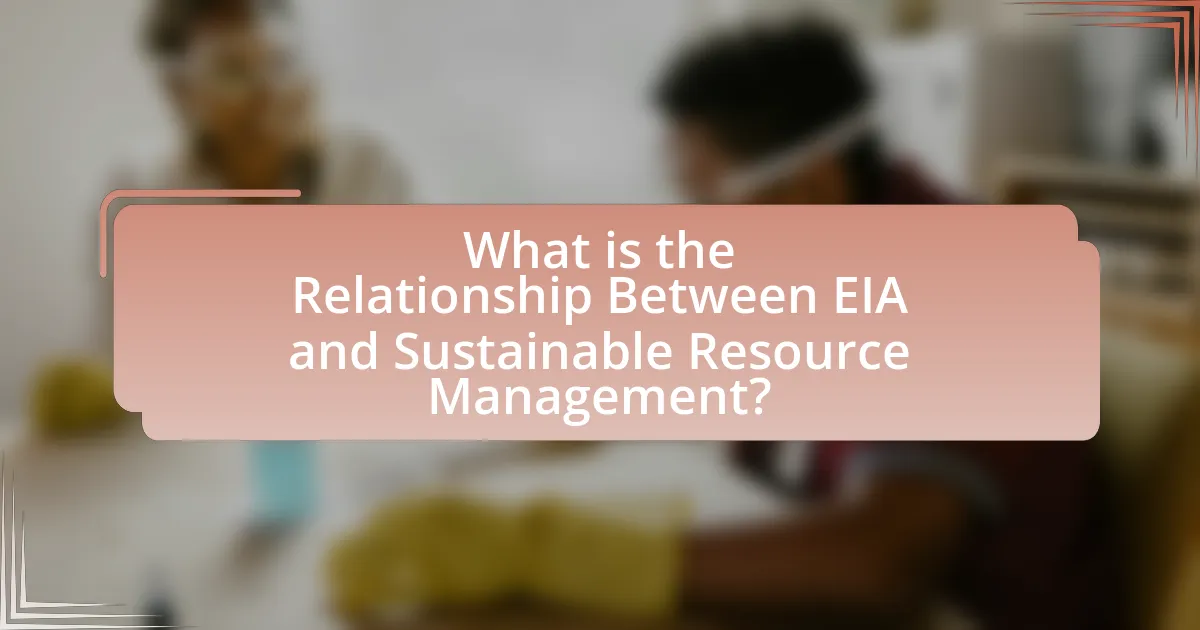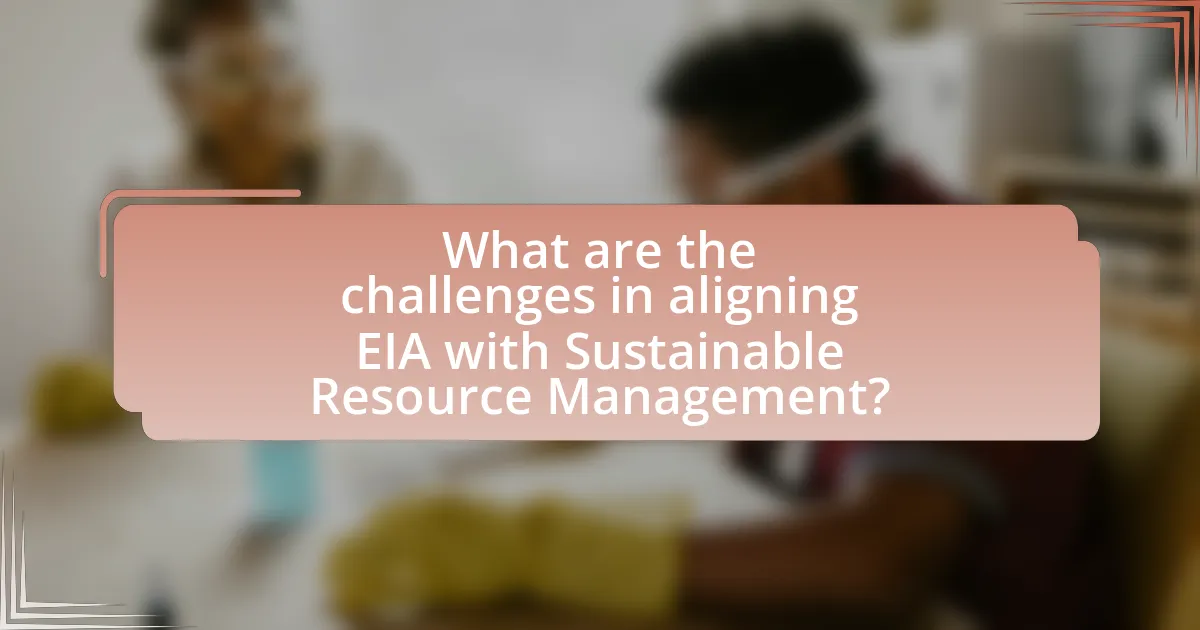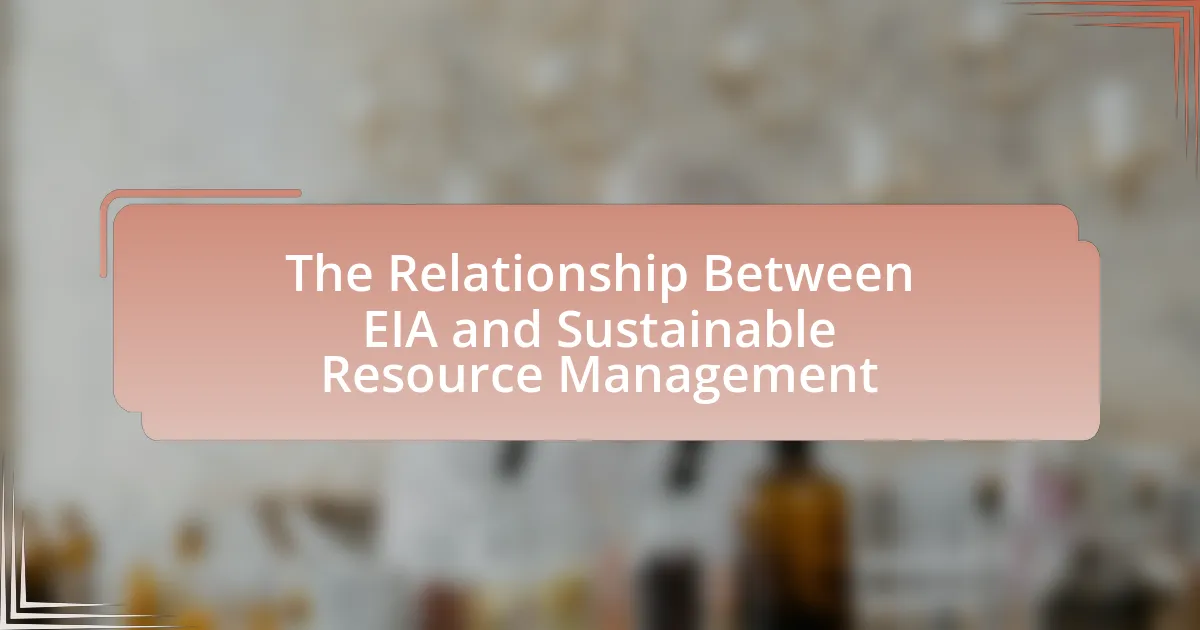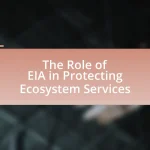The article examines the integral relationship between Environmental Impact Assessment (EIA) and Sustainable Resource Management (SRM). It highlights how EIA serves as a vital tool for evaluating the environmental, social, and economic impacts of proposed projects, thereby facilitating sustainable decision-making. Key principles of EIA, such as public participation and cumulative impact assessment, are discussed in relation to their role in promoting sustainability. The article also addresses challenges in aligning EIA with SRM, including regulatory inconsistencies and inadequate stakeholder engagement, while proposing strategies to enhance EIA effectiveness and adapt to emerging sustainability challenges.

What is the Relationship Between EIA and Sustainable Resource Management?
The relationship between Environmental Impact Assessment (EIA) and Sustainable Resource Management is integral, as EIA serves as a critical tool for evaluating the potential environmental effects of proposed projects, thereby informing sustainable decision-making. EIA processes assess the environmental, social, and economic impacts of projects, ensuring that resource management practices align with sustainability principles. For instance, studies show that effective EIA implementation can lead to better resource allocation and reduced environmental degradation, supporting the long-term viability of ecosystems and communities. This connection underscores the importance of integrating EIA into resource management strategies to promote sustainable development.
How do Environmental Impact Assessments (EIA) contribute to Sustainable Resource Management?
Environmental Impact Assessments (EIA) contribute to Sustainable Resource Management by systematically evaluating the potential environmental effects of proposed projects before they are approved. This proactive approach allows decision-makers to identify and mitigate negative impacts on natural resources, ensuring that development aligns with sustainability goals. For instance, a study by the United Nations Environment Programme highlights that EIAs can lead to better resource allocation and conservation practices, ultimately promoting long-term ecological balance and reducing resource depletion. By integrating environmental considerations into planning processes, EIAs facilitate informed decision-making that supports sustainable development.
What are the key principles of EIA that support sustainability?
The key principles of Environmental Impact Assessment (EIA) that support sustainability include the integration of environmental considerations into decision-making, public participation, and the assessment of cumulative impacts. These principles ensure that potential environmental effects are identified and addressed before project approval, promoting sustainable development. For instance, integrating environmental considerations helps in minimizing adverse effects on ecosystems, while public participation fosters transparency and community involvement, leading to more socially acceptable outcomes. Additionally, assessing cumulative impacts allows for a comprehensive understanding of how multiple projects may collectively affect the environment, thereby supporting long-term sustainability goals.
How does EIA influence decision-making in resource management?
EIA, or Environmental Impact Assessment, significantly influences decision-making in resource management by providing a systematic process for evaluating the potential environmental effects of proposed projects. This assessment helps decision-makers identify and mitigate adverse impacts before project approval, ensuring that resource management aligns with sustainability principles. For instance, a study by the World Bank indicates that projects subjected to EIA are more likely to incorporate environmental considerations, leading to better resource allocation and reduced ecological degradation. By integrating stakeholder input and scientific data, EIA enhances transparency and accountability in resource management decisions, ultimately fostering sustainable development.
Why is the integration of EIA important for sustainable development?
The integration of Environmental Impact Assessment (EIA) is crucial for sustainable development because it systematically evaluates the potential environmental effects of proposed projects before they are approved. This proactive approach ensures that environmental considerations are incorporated into decision-making processes, thereby minimizing negative impacts on ecosystems and communities. For instance, a study by the World Bank indicates that projects with integrated EIA processes are 30% more likely to achieve sustainable outcomes compared to those without such assessments. By identifying potential environmental risks early, EIA facilitates informed choices that align with sustainable resource management principles, ultimately promoting long-term ecological balance and social equity.
What role does EIA play in identifying environmental risks?
Environmental Impact Assessment (EIA) plays a crucial role in identifying environmental risks by systematically evaluating the potential effects of proposed projects on the environment before they are approved. This process involves collecting data, analyzing potential impacts, and engaging stakeholders to ensure that all environmental aspects are considered. For instance, studies have shown that EIA can reduce negative environmental outcomes by up to 30% when properly implemented, as it allows for informed decision-making and the incorporation of mitigation measures.
How can EIA promote stakeholder engagement in resource management?
EIA can promote stakeholder engagement in resource management by facilitating inclusive participation and transparent communication among all relevant parties. This process ensures that stakeholders, including local communities, government agencies, and industry representatives, have opportunities to express their concerns and contribute to decision-making. Research indicates that effective stakeholder engagement through EIA leads to better project outcomes, as it incorporates diverse perspectives and local knowledge, ultimately enhancing the sustainability of resource management practices. For instance, a study by the International Association for Impact Assessment highlights that projects with robust stakeholder involvement are more likely to achieve environmental and social objectives, demonstrating the critical role of EIA in fostering collaborative resource management.

What are the challenges in aligning EIA with Sustainable Resource Management?
The challenges in aligning Environmental Impact Assessment (EIA) with Sustainable Resource Management (SRM) include regulatory inconsistencies, lack of stakeholder engagement, and insufficient data integration. Regulatory inconsistencies arise when EIA frameworks do not align with SRM policies, leading to conflicting objectives and implementation difficulties. Lack of stakeholder engagement often results in inadequate consideration of local knowledge and community needs, which are essential for effective resource management. Insufficient data integration hinders the ability to assess cumulative impacts and long-term sustainability, as EIA processes may not fully incorporate ecological, social, and economic data necessary for informed decision-making. These challenges impede the effectiveness of both EIA and SRM in promoting sustainable development.
What common obstacles hinder effective EIA implementation?
Common obstacles that hinder effective Environmental Impact Assessment (EIA) implementation include inadequate stakeholder engagement, lack of technical expertise, insufficient funding, and regulatory challenges. Inadequate stakeholder engagement often leads to a lack of local knowledge and community support, which can undermine the EIA process. A study by the World Bank highlights that many EIAs fail due to insufficient involvement of affected communities, resulting in incomplete assessments. Lack of technical expertise can result in poorly conducted assessments, as many practitioners may not possess the necessary skills or knowledge to evaluate complex environmental impacts effectively. Insufficient funding limits the scope and depth of EIAs, often leading to rushed or superficial analyses. Regulatory challenges, such as unclear guidelines or inconsistent enforcement, can create confusion and hinder compliance, as noted in research by the United Nations Environment Programme. These obstacles collectively impede the effectiveness of EIA in promoting sustainable resource management.
How do regulatory frameworks impact the effectiveness of EIA?
Regulatory frameworks significantly enhance the effectiveness of Environmental Impact Assessments (EIA) by establishing clear guidelines and standards for assessment processes. These frameworks ensure that EIAs are conducted systematically, promoting consistency and transparency in evaluating potential environmental impacts. For instance, countries with robust regulatory frameworks often require public participation and stakeholder engagement, which leads to more comprehensive assessments and better-informed decision-making. Research indicates that jurisdictions with stringent EIA regulations, such as the European Union, report higher compliance rates and more effective mitigation measures, thereby reinforcing the role of regulatory frameworks in achieving sustainable resource management.
What are the limitations of current EIA practices in resource management?
Current Environmental Impact Assessment (EIA) practices in resource management face several limitations, including inadequate stakeholder engagement, insufficient consideration of cumulative impacts, and a lack of integration with strategic planning. Inadequate stakeholder engagement often leads to the exclusion of local communities and indigenous knowledge, which can result in decisions that do not reflect the needs or values of those affected. Insufficient consideration of cumulative impacts fails to account for the combined effects of multiple projects over time, potentially leading to significant environmental degradation. Additionally, the lack of integration with strategic planning processes means that EIAs may not align with broader sustainability goals, undermining their effectiveness in promoting sustainable resource management. These limitations hinder the ability of EIAs to fully assess and mitigate environmental risks associated with resource development.
How can these challenges be addressed to enhance EIA effectiveness?
Enhancing Environmental Impact Assessment (EIA) effectiveness can be achieved by integrating stakeholder engagement, improving data quality, and ensuring regulatory compliance. Stakeholder engagement fosters collaboration and transparency, which can lead to more comprehensive assessments and community support. Improving data quality involves utilizing advanced technologies and methodologies to gather accurate environmental data, thereby increasing the reliability of EIA outcomes. Ensuring regulatory compliance through regular audits and updates to EIA processes can help maintain standards and adapt to evolving environmental challenges. These strategies collectively contribute to a more robust EIA framework, ultimately supporting sustainable resource management.
What best practices can be adopted for better EIA outcomes?
To achieve better Environmental Impact Assessment (EIA) outcomes, adopting a comprehensive stakeholder engagement process is essential. Engaging stakeholders early and throughout the EIA process ensures that diverse perspectives are considered, leading to more informed decision-making. Research indicates that projects with robust stakeholder involvement tend to have higher acceptance rates and fewer conflicts (Reed et al., 2009, “Who’s in the Room? A Systematic Review of Stakeholder Engagement in Environmental Impact Assessment,” Environmental Impact Assessment Review). Additionally, integrating adaptive management practices allows for ongoing monitoring and adjustments based on environmental feedback, enhancing the effectiveness of EIA outcomes.
How can technology improve the EIA process in resource management?
Technology can improve the Environmental Impact Assessment (EIA) process in resource management by enhancing data collection, analysis, and stakeholder engagement. Advanced tools such as Geographic Information Systems (GIS) allow for precise mapping and spatial analysis of environmental impacts, enabling more informed decision-making. Additionally, remote sensing technologies provide real-time data on environmental conditions, which can be integrated into the EIA process to assess potential impacts more accurately. Furthermore, digital platforms facilitate better communication and collaboration among stakeholders, ensuring that diverse perspectives are considered in the assessment. These technological advancements lead to more efficient, transparent, and effective EIAs, ultimately supporting sustainable resource management practices.

What are the future trends in EIA and Sustainable Resource Management?
Future trends in Environmental Impact Assessment (EIA) and Sustainable Resource Management (SRM) include increased integration of technology, enhanced stakeholder engagement, and a focus on climate resilience. The adoption of advanced technologies such as artificial intelligence and big data analytics is transforming EIA processes by improving data collection and analysis, leading to more informed decision-making. Enhanced stakeholder engagement is becoming essential, as inclusive practices ensure that diverse perspectives are considered, fostering transparency and community trust. Additionally, the emphasis on climate resilience is driving both EIA and SRM to prioritize adaptive strategies that mitigate environmental risks and promote sustainability. These trends are supported by the growing recognition of the interconnectedness of environmental, social, and economic factors in achieving sustainable development goals.
How is the role of EIA evolving in the context of climate change?
The role of Environmental Impact Assessment (EIA) is evolving to incorporate climate change considerations more systematically into project evaluations. This evolution is driven by the increasing recognition of climate change as a critical factor influencing environmental sustainability and project viability. For instance, regulatory frameworks in various countries are now mandating that EIAs assess greenhouse gas emissions and climate resilience, reflecting a shift towards integrating climate risks into decision-making processes. Additionally, the Paris Agreement has prompted nations to enhance their EIA practices to align with global climate goals, ensuring that projects contribute positively to climate adaptation and mitigation efforts.
What innovative approaches are being developed for EIA?
Innovative approaches being developed for Environmental Impact Assessment (EIA) include the integration of advanced technologies such as Geographic Information Systems (GIS), remote sensing, and artificial intelligence (AI). These technologies enhance data collection, analysis, and visualization, allowing for more accurate assessments of environmental impacts. For instance, GIS enables spatial analysis of potential impacts on ecosystems, while AI can predict outcomes based on historical data, improving decision-making processes. Additionally, stakeholder engagement platforms are being utilized to incorporate public input more effectively, fostering transparency and collaboration in the EIA process. These advancements aim to streamline assessments and promote sustainable resource management by ensuring that environmental considerations are thoroughly integrated into planning and development activities.
How can EIA adapt to emerging sustainability challenges?
EIA can adapt to emerging sustainability challenges by integrating comprehensive assessments that consider long-term environmental impacts and stakeholder engagement. This adaptation involves updating methodologies to include climate change projections, biodiversity considerations, and social equity factors, ensuring that assessments reflect current sustainability priorities. For instance, the International Association for Impact Assessment emphasizes the need for EIA frameworks to incorporate adaptive management strategies, which allow for ongoing adjustments based on new information and changing conditions. This approach enhances the relevance and effectiveness of EIA in addressing complex sustainability issues.
What practical steps can organizations take to enhance EIA in resource management?
Organizations can enhance Environmental Impact Assessment (EIA) in resource management by implementing comprehensive stakeholder engagement processes. Engaging stakeholders, including local communities and experts, ensures diverse perspectives are considered, leading to more informed decision-making. Research indicates that effective stakeholder involvement can improve the quality of EIA outcomes, as seen in case studies where community input led to better environmental protection measures. Additionally, organizations should adopt adaptive management practices that allow for ongoing monitoring and adjustment of resource management strategies based on EIA findings. This approach has been shown to increase the resilience of ecosystems and improve sustainability outcomes, as evidenced by projects that have successfully integrated adaptive management into their EIA processes.
How can organizations ensure compliance with EIA regulations?
Organizations can ensure compliance with Environmental Impact Assessment (EIA) regulations by implementing a structured framework that includes thorough assessments, stakeholder engagement, and adherence to legal requirements. This involves conducting comprehensive environmental assessments prior to project initiation, which helps identify potential impacts and mitigation strategies. Furthermore, organizations must engage with stakeholders, including local communities and regulatory bodies, to gather input and ensure transparency throughout the EIA process. Compliance is also reinforced by regularly reviewing and updating internal policies to align with evolving EIA regulations and best practices, as demonstrated by the success of companies that have integrated EIA compliance into their project management processes, leading to reduced environmental risks and enhanced sustainability outcomes.
What strategies can be implemented for effective stakeholder collaboration?
Effective stakeholder collaboration can be achieved through strategies such as establishing clear communication channels, fostering trust, and engaging stakeholders early in the decision-making process. Clear communication ensures that all parties understand project goals and expectations, which is supported by research indicating that effective communication can enhance collaboration outcomes (Bourne & Walker, 2006). Trust-building activities, such as team-building exercises and transparency in sharing information, create a collaborative environment, as evidenced by studies showing that trust significantly influences stakeholder engagement (Mayer, Davis, & Schoorman, 1995). Engaging stakeholders early allows for their input to shape project development, leading to better alignment with community needs and increased project acceptance, as highlighted in the International Association for Impact Assessment’s guidelines on stakeholder engagement.


